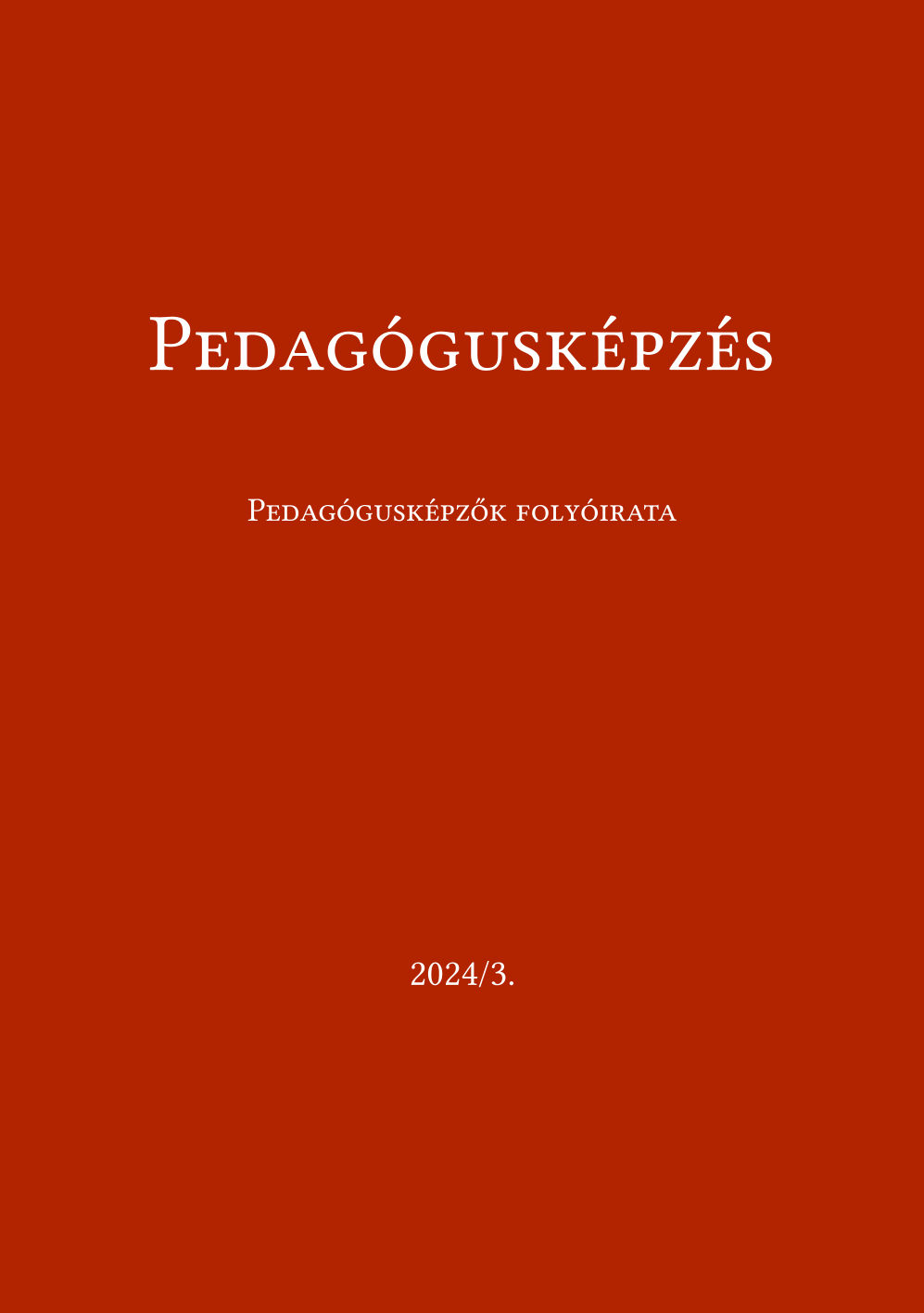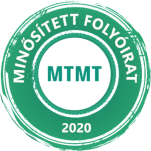Az Imposztorprofil-kérdőív magyar nyelvű hallgatói változatának kidolgozása és relevanciája a pedagógusképzésben
DOI:
https://doi.org/10.37205/TEL-hun.2024.3.01Kulcsszavak:
felsőoktatásban tanuló hallgatók, imposztorjelenség, imposztorprofil-kérdőív, skálaadaptáció, faktorelemzésAbsztrakt
Az imposztorjelenség összetett pszichológiai állapot, melynek során magas teljesítményt nyújtó egyének kétségbe vonják saját képességeiket és sikereiket, úgy érzik, másokat becsapnak, és attól tartanak, hogy lelepleződnek mint intellektuális csalók.
Kutatásunk célja az Ibrahim és munkatársai (2022) által kidolgozott IPP30 (Impostor-Profile) kérdőív magyar nyelvű adaptációjának elkészítése és belső koherenciájának ellenőrzése volt. Az IPP30-kérdőívet négy szakértő fordította magyarra. A magyar nyelvű verziót 311 egyetemi hallgató töltötte ki online formában. Az adatokat feltáró és megerősítő faktorelemzéssel vizsgáltuk SPSS és Jamovi szoftverek segítségével.
Az eredeti 30 itemes kérdőív szerkezete nem működött megfelelően a magyar mintán, ezért egy rövidített, 15 itemes verziót hoztunk létre, amely megtartotta az eredeti hatfaktoros szerkezetet. Az új, magyar nyelvű skála kiváló illeszkedési mutatókkal rendelkezik (CFI = 0,974, TLI = 0,964, SRMR = 0,0401, RMSEA = 0,051). A kialakított faktorok Cronbach-α értékei 0,733 és 0,928 között mozognak, a teljes skáláé 0,774. A vizsgálat megerősítette, hogy az imposztorjelenség hatfaktoros modellje adaptálható magyar nyelvre. Az eredmények azt mutatják, hogy a pedagógusképzésben részt vevő hallgatók más tudományterületeken tanuló társaiknál jobban érintettek az imposztorjelenségben. Emellett összefüggést találtunk a társadalmi mobilitás és az imposztorjelenségben való érintettség között, különösen azoknál az első generációs hallgatóknál, akiknek édesanyja nem rendelkezik érettségivel.
Hivatkozások
Bravata, D. M, Watts S. A., Keefer A. L., Madhusudhan D. K., Taylor K. T., Clark D. M., Nelson R. S., Cokley K. O. & Hagg H. K. (2020).
Prevalence, Predictors, and Treatment of Impostor Syndrome: a Systematic Review. Journal of General Internal Medicine, 35(4), 1252–1275. https://doi.org/10.1007/s11606-019-05364-1
Chakraverty, D. (2022). Faculty Experiences of the Impostor Phenomenon in STEM Fields. CBE Life Sciences Education, 21, 1–16. https://doi.org/10.1187/cbe.21-10-0307.
Chrisman, S. M., Pieper, W. A., Clance, P. R., Holland, C. L. & Glickauf-Hughes, C. (1995). Validation of the Clance Imposter Phenomenon Scale. Journal of Personality Assessment, 65(3), 456–467. https://10.1207/s15327752jpa6503_6
Clance, P. R. & Imes, S. A. (1978). The imposter phenomenon in high achieving women: Dynamics and therapeutic intervention. Psychotherapy: Theory, Research & Practice, 15(3), 241–247. https://doi.org/10.1037/h0086006
Cokley, K., Awad, G., Smith, L., Jackson S., Awosogba, O., Hurst, A., Stone, S., Blondeau, L. & Roberts. D. (2015). The roles of gender stigma consciousness, impostor phenomenon and academic self-concept in the academic outcomes of women and men. Sex Roles, 73(9–10), 414–426. https://doi.org/10.1007/s11199-015-0516-7
Cozzarelli, C. & Major, B. (1990). Exploring the Validity of the Impostor Phenomenon. Journal of Social and Clinical Psychology, 9(4), 401–417. https://doi.org/10.1521/jscp.1990.9.4.401
Csereklye, E. (2024). Sikerült őket meggyőznöm arról, hogy én egy nagyon érdekes kutató lehetek: A doktori hallgatók szakmai szocializációjáról. In Gordon Győri, J. & Bajzáth, A. (Eds.), Elkötelezettség és rugalmasság: a neveléstudomány útjai az átalakuló világban (pp. 215–226). Eötvös Loránd Tudományegyetem Pedagógiai és Pszichológiai Kar.
De Santiago Campos, I., Camara, G., Carneiro, A., Kubrusly, M., Peixoto, R. & Júnior, A. (2022). Impostor Syndrome and its association with depression and burnout among medical students. Revista Brasileira de Educação Médica, 46(02), 1–8. https://doi.org/10.1590/1981-5271v46.2-20200491.ing
Duckworth, A. L. & Quinn, P. D. (2009). Development and Validation of the Short Grit Scale (Grit–S). Journal of Personality Assessment, 91(2), 166–174. https://doi.org/10.1080/00223890802634290
Durst, J., Nyírő, Zs. & Berményi, Á. (Eds.) (2022). A társadalmi mobilitás ára. Első generációs diplomások és az osztályváltás következményei. Gondolat Kiadó – Társadalomtudományi Kutatóközpont.
Dweck, C. (2006). Mindset: The new psychology of success. Random House.
Edwards-Maddox, S. (2022). Burnout and impostor phenomenon in nursing and newly li-censed registered nurses: A scoping review. Journal of clinical nursing, 32(5–6), 653–665. https://doi.org/10.1111/jocn.16475
Eisinga, R., Grotenhuis, M. & Pelzer B. (2012). The reliability of a two-item scale: Pearson, Cronbach, or Spearman-Brown? International Journal of Public Health, 58(4) 637–642. https://doi.org/10.1007/s00038-012-0416-3.
Elekes, Zs. (2009). Egy változó kor változó ifjúsága. Fiatalok alkohol- és egyéb drogfogyasztása Magyarországon - ESPAD 2007. L'Harmattan Kiadó
Freeman, K., Carr, S., Phillips, B., Noya, F. & Nestel, D. (2022). From clinician to educator: A scoping review of professional identity and the influence of impostor phenomenon. The Asia Pacific Scholar. https://doi.org/10.29060/taps.2022-7-1/ra2537.
Fujie, R. (2010). Development of the State Impostor Phenomenon Scale. Japanese Psychological Research, 52(1), 1–11. https://doi.org/10.1111/j.1468-5884.2009.00417.x
Goldszmidt, M., Zibrowski, E. & Legassie, J. (2008). Measuring Resident Well-Being: Impostorism and Burnout Syndrome in Residency. Journal of General Internal Medicine, 24(3), 441–441. https://doi.org/10.1007/s11606-008-0874-8
Harvey, J. C. (1981). The impostor phenomenon and achievement: A failure to internalize success. PhD dissertation. Temple University ProQuest Dissertations & Theses, 1981. 8210500 https://doi.org/10.1037/t01755-000
Harvey, J. C. & Katz, C. (1985). If I’m So Successful, Why Do I Feel Like a Fake? The Impostor Phenomenon. St Martin’s Press.
Hazag, A., Major, J. & Ádám, Sz. (2010). A Hallgatói Kiégés Szindróma mérése. A Maslach Kiégés-teszt Hallgatói Változatának (MBI-SS) validálása hazai mintán. Mentálhigiéné és Pszichoszomatika, 11(2), 151–168. https://doi.org/10.1556/Mental.11.2010.2.4
Ibrahim, F., Münscher, J. C. & Herzberg, P. Y. (2020). The facets of an impostor – Development and validation of the impostor-profile (IPP31) for measuring impostor phenomenon. Current Psychology, 41, 3916–3917. https://doi.org/10.1007/s12144-020-00895-x
Ibrahim, F., Göddertz, D. & Herzberg, P. Y. (2022). The validation of the English Impostor-Profile 30 and the exploratory formulation of the learned helplessness model of the impostor phenomenon. Acta Psychologica, 226(103589) https://doi.org/10.1016/j.actpsy.2022.103589
Ibrahim, F., Göddertz, D. & Herzberg, P. Y. (2023). An experimental study of the non-self-serving attributional bias within the impostor phenomenon and its relation to the fixed mindset. Current Psychology, 42, 26440–26449. https://doi.org/10.1007/s12144-022-03486-0
King, J. E. & Cooley, E. L. (1995). Achievement orientation and the impostor phenomenon among college students. Contemporary Educational Psychology, 20(3), 304–312, https://doi.org/10.1006/ceps.1995.1019
Kolligian, J. & Sternberg, R. J. (1991). Perceived fraudulence in young adults: is there an “impostor syndrome”? Journal of Personality Assessment, 56(2), 308–326. https://doi.org/10.1207/s15327752jpa5602_10
Kőváry Z., Devecsery Á., Jakab K., Pusztai B., Agócs L., Kómár R. & Orosz G. (2014). Az Érzelmi Kreativitás Leltár (ECI) Hazai adaptációja. Pszichológia 34(4). 339–362. https://doi.org/10.1556/Pszicho.34.2014.4.2
Leary, M. R., Patton, K. M., Orlando, E. & Funk, W. W. (2000). The impostor phenomenon: self-perceptions, reflected appraisals, and interpersonal strategies. Journal of Personality, 68(4), 725–756. https://doi.org/10.1111/1467-6494.00114
Mak, K. K. L., Kleitman, S. & Abbott, M. J. (2019). Impostor Phenomenon Measurement Scales: A Systematic Review. Frontiers in Psychology, Section Quantitative Psychology and Measurement, 10(671), 1–15. https://doi.org/10.3389/fpsyg.2019.00671
Matthews, G. & Clance, P. (1985). Treatment of the impostor phenomenon in psychotherapy clients. Psychotherapy in Private Practice, 3(1), 71–81. https://doi.org/10.1300/j294v03n01_09
Nápoles, J., Springer, D., Silvey, B., Montemayor, M. & Rinn, T. (2023). Burnout and Impostor Phenomenon Among Undergraduate Music Education Majors. Journal of Research in Music Education, 72(3), 229–246. https://doi.org/10.1177/00224294231207267
Naser, M., Hasan, N., Zainaldeen, M., Zaidi, A., Mohamed, Y. & Fredericks, S. (2022). Impostor Phenomenon and Its Relationship to Self-Esteem Among Students at an International Medical College in the Middle East: A Cross Sectional Study. Frontiers in Medicine, 9, 1–9. https://doi.org/10.3389/fmed.2022.850434
Noskeau, R., Santos, A. & Wang, W. (2021). Connecting the Dots Between Mindset and Impostor Phenomenon, via Fear of Failure and Goal Orientation, in Working Adults. Frontiers in Psychology. Section Organizational Psychology, 12(588438). https://doi.org/10.3389/fpsyg.2021.588438
Price, P. C., Holcomb, B. & Payne, M. B. (2024). Gender differences in impostor phenomenon: A meta-analytic review. Current Research in Behavioral Sciences, 7, 100155, https://doi.org/10.1016/j.crbeha.2024.100155
Rudenga, K. & Gravett, E. (2020). Impostor Phenomenon in Educational Developers. Consequences and Coping Strategies, 39, 1–25. https://doi.org/10.3998/tia.17063888.0039.201.
Schubert, N. & Bowker, A. (2017). Examining the Impostor Phenomenon in Relation to Self-Esteem Level and Self-Esteem Instability. Current Psychology, 38, 749–755. https://doi.org/10.1007/s12144-017-9650-4
Sims, W. & Cassidy, J. (2018). Impostor Phenomenon Responses of Early Career Music Education Faculty. Journal of Research in Music Education, 67, 45–61. https://doi.org/10.1177/0022429418812464.
Urbán, R., Szigeti, R., Kökönyei, Gy. & Demetrovics, Zs. (2014). Global self-esteem and method effects: Competing factor structures, longitudinal invariance, and response styles in adolescents. Behavior Research Methods, 46, 488–498. https://doi.org/10.3758/s13428-013-0391-5
##submission.downloads##
Megjelent
Hogyan kell idézni
Folyóiratszám
Rovat
License
Copyright (c) 2025 A szerző(k)

This work is licensed under a Creative Commons Attribution-NonCommercial-NoDerivatives 4.0 International License.








